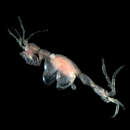Pariambus typicus: Brief Summary
provided by wikipedia EN
Pariambus typicus is a species of amphipod crustacean. It is found in the Atlantic Ocean from northern Norway south to the Cape Verde Islands and into the Mediterranean Sea as far east as Italy. It is absent from the Baltic Sea, suggesting that it requires water of high salinity. Adults grow to a length of 7 millimetres (0.28 in), and are commonly found in association with starfish and sea urchins, and more rarely with brittle stars. The species is sometimes included in the family Pariambidae, but more usually in the Caprellidae.
- license
- cc-by-sa-3.0
- copyright
- Wikipedia authors and editors
Description
provided by World Register of Marine Species
Ghost shrimps are characterised by a slender, cylindrical body with less appendages than other amphipods. The males are large and slender whereas the females are stockier. Up to 7 mm long, elongate and transparent body clearly separated into segments. Central segments have rudimentary legs.
Degraer, S.; Wittoeck, J.; Appeltans, W.; Cooreman, K.; Deprez, T.; Hillewaert, H.; Hostens, K.; Mees, J.; Vanden Berghe, E.; Vincx, M. (2006). The macrobenthos atlas of the Belgian part of the North Sea. Belgian Science Policy. D/2005/1191/3. ISBN 90-810081-6-1. 164 pp.
- license
- cc-by-4.0
- copyright
- WoRMS Editorial Board
Distribution
provided by World Register of Marine Species
In the 1976-1986 period Pariambus typicus was found across the entire Belgian part of the North Sea with a low distribution frequency. In the 1994-2001 period the distribution frequency increased but the distribution was limited to the near-coastal zone, with the exception of the eastern costal zone. The density levels increased as well: from a maximum of 220 ind./m2 in the 1976-1986 period to a maximum of 15,000 ind./m2 in the 1994-2001 period.
Degraer, S.; Wittoeck, J.; Appeltans, W.; Cooreman, K.; Deprez, T.; Hillewaert, H.; Hostens, K.; Mees, J.; Vanden Berghe, E.; Vincx, M. (2006). The macrobenthos atlas of the Belgian part of the North Sea. Belgian Science Policy. D/2005/1191/3. ISBN 90-810081-6-1. 164 pp.
- license
- cc-by-4.0
- copyright
- WoRMS Editorial Board
Habitat
provided by World Register of Marine Species
Pariambus typicus is observed in fine to coarse-grained sediments (median grain size 100 to 500 µm) with a maximum mud content of 40%. Preference is given to sediments with a median grain size of 150 to 250 µm (relative occurrence: > 30%) and a mud content of 10 to 40% (relative occurrence: up to 60%).
Degraer, S.; Wittoeck, J.; Appeltans, W.; Cooreman, K.; Deprez, T.; Hillewaert, H.; Hostens, K.; Mees, J.; Vanden Berghe, E.; Vincx, M. (2006). The macrobenthos atlas of the Belgian part of the North Sea. Belgian Science Policy. D/2005/1191/3. ISBN 90-810081-6-1. 164 pp.
- license
- cc-by-4.0
- copyright
- WoRMS Editorial Board

